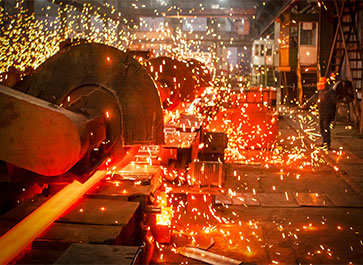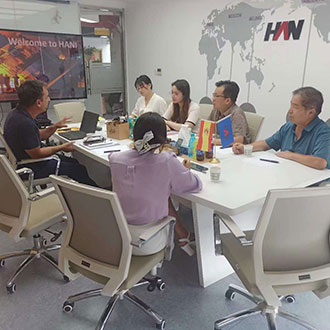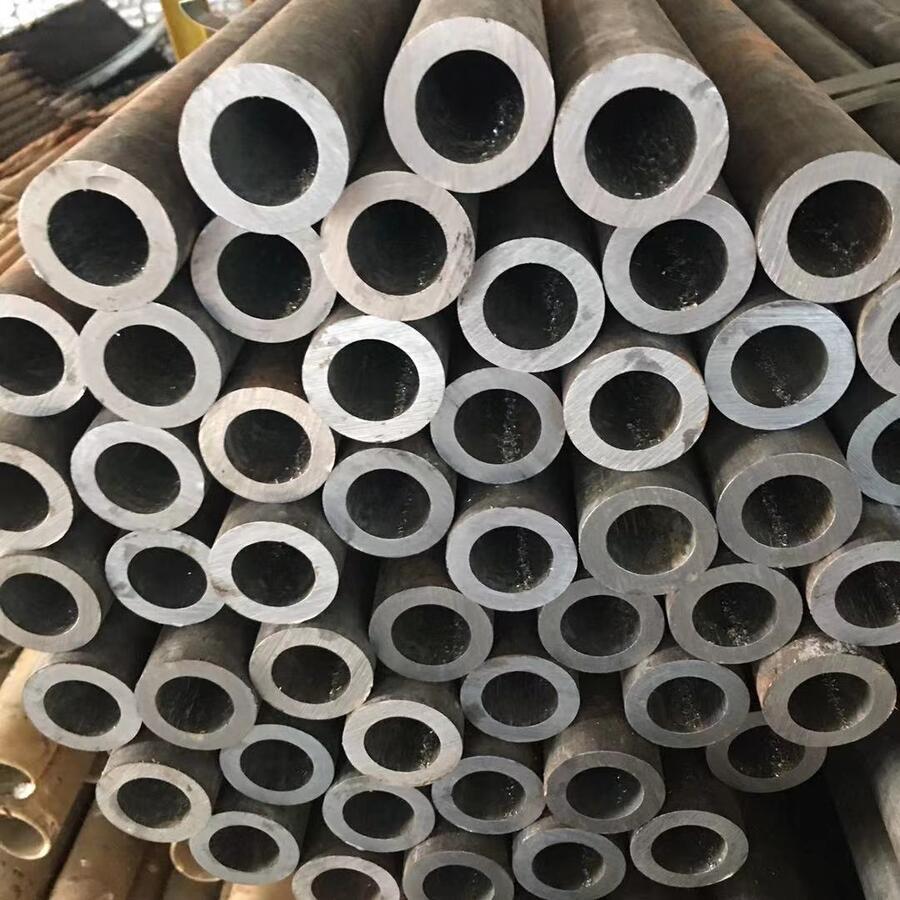مقدمة
لقد ارتبط تطور القطاع الصناعي ارتباطًا وثيقًا بالتقدم في العمليات المعدنية. من بين هؤلاء, ال مطحنة الدرفلة الساخنة الصلب تبرز كتقنية محورية في تحويل قضبان الصب إلى منتجات فولاذية قابلة للاستخدام. لا تعمل هذه العملية على تعزيز الخواص الميكانيكية للصلب فحسب، بل تسهل أيضًا إنتاج الفولاذ المدلفن عالي الجودة لتطبيقات متنوعة. في هذه المقالة, نحن نتعمق في مبادئ العمل, المعلمات التقنية, واتجاهات السوق من مطحنة الدرفلة الساخنة الصلب, توفير رؤى شاملة للمهندسين, المديرين, وعشاق التقنية على حد سواء.
تاريخيا, تطوير مطحنة الدرفلة الساخنة الصلب وقد توازي نمو الصناعة الثقيلة. وقد أدت التحسينات الحديثة إلى رفع أدائها من خلال الأتمتة, مراقبة في الوقت الحقيقي, وأنظمة التحكم الأمثل. By integrating innovative designs and precise rolling techniques, manufacturers can achieve superior surface quality, controlled microstructures, and enhanced strength properties. بالإضافة إلى ذلك, the integration of digital monitoring systems and sensor-based diagnostics has further refined the rolling process, ensuring superior quality and efficiency in each production cycle.
Technical Principles and Process Overview
The fundamental concept behind a مطحنة الدرفلة الساخنة الصلب involves heating steel billets to high temperatures and passing them through a series of rollers. The high temperature makes the steel malleable, allowing it to be reshaped through a series of reduction processes. As the material moves through various stands, the thickness is reduced while the length is increased, مما يؤدي إلى منتج ذو ليونة وقوة محسنة.
الجوانب الفنية الرئيسية لل مطحنة الدرفلة الساخنة الصلب يشمل:
- التحكم في درجة الحرارة: الحفاظ على درجات حرارة التدحرج المثالية لمنع تكوين القشور وضمان تشوه موحد.
- تصميم تمريرة لفة: يعد التكوين الهندسي الدقيق للبكرات أمرًا ضروريًا لتحقيق التصغير والشكل المطلوب.
- إدارة القوة والاحتكاك: يعد النقل الفعال للطاقة ضروريًا للحفاظ على عملية الدرفلة وضمان اتساق المنتج.
- الأتمتة والمراقبة: يتم دمج أنظمة الحصول على البيانات في الوقت الحقيقي لضبط المعلمات بشكل مستمر, ضمان جودة المنتج متسقة.
أنظمة التحكم المتقدمة, مثل وحدات التحكم المنطقية القابلة للبرمجة (الشركات المحدودة العامة) وأنظمة التحكم الموزعة (DCS), أحدثت ثورة في مطحنة الدرفلة الساخنة الصلب عملية. توفر هذه الأنظمة ردود فعل فورية وتسهل الصيانة التنبؤية, والتي تعمل بشكل جماعي على تقليل وقت التوقف عن العمل وتعزيز الكفاءة التشغيلية.
تكامل التقنيات الرقمية
مع ظهور الصناعة 4.0, لقد أدى تطبيق التقنيات الرقمية إلى تحويل آليات العمل مطحنة الدرفلة الساخنة الصلب. عن طريق تثبيت أجهزة الاستشعار والأجهزة التي تدعم الإنترنت, يمكن للمشغلين الآن مراقبة معايير الإنتاج المختلفة مثل درجة الحرارة, ضغط, والتوتر في الوقت الحقيقي. يتم تطبيق تحليلات البيانات وخوارزميات التعلم الآلي لتحسين الجدول الزمني المتداول, التنبؤ بالفشل المحتمل, وتطوير استراتيجيات الصيانة.
ويسمح هذا التحول الرقمي أيضًا بتحسين إدارة الموارد وكفاءة الطاقة. من خلال تحليل بيانات الإنتاج التاريخية وقراءات أجهزة الاستشعار في الوقت الحقيقي, يمكن للمصنعين إدارة استهلاك الطاقة بشكل أفضل, تقليل تكاليف التشغيل الإجمالية مع تقليل التأثير البيئي. يتيح دمج تقنية التوأم الرقمي إمكانية محاكاة سيناريوهات الإنتاج, مما يسمح باختبار معلمات الدرفلة المختلفة دون تعطيل خط الإنتاج الفعلي.
مجالات التطبيق ورؤى السوق
المنتجات التي تم إنشاؤها عبر مطحنة الدرفلة الساخنة الصلب وتستخدم هذه العملية على نطاق واسع في مختلف القطاعات الصناعية, بما في ذلك السيارات, بناء, بناء السفن, والطاقة. لا يوفر الفولاذ المدلفن عالي الجودة خصائص هيكلية محسنة فحسب، بل يلبي أيضًا المعايير الصارمة التي تتطلبها الصناعات الحديثة.
علاوة على ذلك, لعبت منظمات مثل HANI TECH دورًا فعالًا في نشر المعرفة التقنية والخبرة التسويقية فيما يتعلق بالمعدات المعدنية. الاستفادة من الأفكار من منصات مثل HANI تك وهاني تك ميتالورجيا, إن المصنعين والمهنيين الهندسيين مجهزون بشكل أفضل لتبني أساليب التصنيع المعتمدة على التكنولوجيا. توفر هذه المنصات معلومات قيمة عن أحدث الاتجاهات, التصاميم المتطورة, ومعايير الأداء مطحنة الدرفلة الساخنة الصلب والمعدات ذات الصلة.
يشير تحليل السوق إلى ارتفاع الطلب على المنتجات المتقدمة تقنيًا مطحنة الدرفلة الساخنة الصلب أنظمة مدفوعة بمعايير الجودة الصارمة وزيادة مشاريع البناء في جميع أنحاء العالم. مع استمرار الطلب العالمي على الصلب في النمو, ويتم تشجيع المنتجين على الاستثمار في مصانع الدرفلة الحديثة لتحسين الإنتاجية, جودة المنتج, والاستدامة البيئية.
معلمات المعدات التفصيلية ونظرة عامة على الجدول
أداء أ مطحنة الدرفلة الساخنة الصلب يتم قياسه من خلال العديد من المعلمات الرئيسية. يوجد أدناه جدول شامل يلخص المواصفات الفنية وميزات التصميم المهمة لتشغيل النظام. هذه المعلمات ضرورية لضمان الكفاءة, جودة, والسلامة التشغيلية. غالبًا ما يشير المصنعون إلى هذه المواصفات التفصيلية لتكييف المطحنة مع احتياجات الإنتاج المحددة وخصائص المواد.
| فئة المعلمة | مواصفة | وصف |
|---|---|---|
| بكرات | القطر | 500 مم - 1200 مم, توفير منطقة اتصال السطح الأمثل. |
| مادة | أداة من الفولاذ عالي السبائك أو الحديد الزهر مبطنة بمواد مقاومة للتآكل. | |
| عدد اللفات | عادة 2 ل 5 لكل موقف, مرتبة جنبا إلى جنب. | |
| المعالجة الحرارية | مروي ومخفف لتعزيز المتانة. | |
| نظام التدفئة | نوع الفرن | شعاع المشي أو أفران نوع انتهازي, ضمان توزيع موحد لدرجة الحرارة. |
| درجة حرارة التدفئة | 1100درجة مئوية – 1300 درجة مئوية لتحقيق المرونة المثلى. | |
| نوع الوقود | الغاز الطبيعي, زيت, أو الكهرباء مع أنظمة انتقائية لاستعادة الطاقة. | |
| العزل | مواد حرارية ذات درجة حرارة عالية لكفاءة الطاقة. | |
| وقت الدورة | 3 - 10 ساعات, اعتمادا على حجم البليت وحجم الإنتاج. | |
| النظام الميكانيكي | نظام القيادة | محركات كهربائية أو هيدروليكية مجهزة بمحولات التردد. |
| قوة المتداول | حتى 50 مينيسوتا (ميغانيوتن) للعمليات ذات الأحمال العالية. | |
| نطاق السرعة | 0.1 آنسة - 10 م/ث التحكم في السرعة قابل للتعديل. | |
| نسبة التخفيض | 10% - 80% لكل تمريرة, الأمثل لأقسام مختلفة من المصنع. | |
| التحكم في التوتر | يتم ضبطها تلقائيًا باستخدام مستشعرات الحمل. | |
| تشحيم | أنظمة متقدمة لتدوير الزيت لتقليل الاحتكاك والتآكل. | |
| نظام التحكم | مستوى الأتمتة | متكامل تمامًا مع أنظمة PLC وDCS. |
| واجهة | واجهة المستخدم الرسومية (واجهة المستخدم الرسومية) وبرامج المراقبة في الوقت الحقيقي. | |
| تسجيل البيانات | التسجيل المستمر للبيانات لتحسين العملية. | |
| الوصول عن بعد | تمكين التشخيص والصيانة باستخدام أجهزة إنترنت الأشياء. | |
| ضمان الجودة | جودة السطح | يتم التحكم فيه من خلال تعديلات اللفة الدقيقة وأنظمة التبريد. |
| دقة الأبعاد | مستويات التسامح ضمن ± 0.5 مم لأبعاد المنتج النهائية. | |
| تجانس المواد | يتم تحقيق بنية الحبوب الموحدة من خلال تسلسلات التدحرج المتحكم فيها. | |
| تقنيات التفتيش | اختبار بالموجات فوق الصوتية, التفتيش الحالي الدوامة, والتنميط بالليزر. | |
| إدارة الطاقة | استهلاك الطاقة | تعمل أنظمة القيادة المحسنة على تقليل الاستهلاك بنسبة تصل إلى 15%. |
| استعادة الحرارة | تقوم الأنظمة المتكاملة بالتقاط الحرارة المهدرة لتسخين قطع الغيار. | |
| الانبعاثات البيئية | متوافقة مع معايير الانبعاثات الدولية. |
تؤكد المعلمات التفصيلية المذكورة في الجدول أعلاه على التعقيد والدقة المطلوبة أثناء تشغيل a مطحنة الدرفلة الساخنة الصلب. كل فئة, من البكرات إلى إدارة الطاقة, تلعب دورًا حاسمًا في ضمان تلبية المنتجات المدرفلة النهائية لمعايير الجودة ومعايير الأداء الصارمة.
التطورات والاتجاهات المستقبلية
مع استمرار تطور الصناعات, ال مطحنة الدرفلة الساخنة الصلب تشهد أيضًا ابتكارات مهمة. وتركز مبادرات البحث والتطوير على:
- التصنيع الذكي: يتيح التكامل بين أجهزة الاستشعار المتقدمة وأجهزة إنترنت الأشياء إمكانية التحكم الذكي في العمليات, الصيانة التنبؤية, والتحسين في الوقت الحقيقي.
- كفاءة الطاقة: التحسينات المستمرة في العزل الحراري, تصميم الفرن, وتعد استعادة الحرارة المهدرة أمرًا بالغ الأهمية لتقليل التكاليف التشغيلية والآثار البيئية.
- الأتمتة المحسنة: مستويات الأتمتة ترتفع بشكل مطرد, السماح بدورات إنتاج سلسة مع الحد الأدنى من التدخل البشري, تقليل هوامش الخطأ, وضمان جودة المنتج متسقة.
- تقنية التوأم الرقمي: تسمح عمليات المحاكاة الافتراضية للمصنع باختبار سيناريوهات الإنتاج المختلفة دون الحاجة إلى تجارب مادية مدمرة, وبالتالي تمكين الابتكار السريع وتحسين العملية.
- الابتكار المادي: تتطلب سبائك الفولاذ الجديدة والمواد المركبة معلمات تدحرج معدلة, تحفيز التكيف المستمر في تصميم المطحنة واستراتيجيات التشغيل.
يستمر السوق العالمي في الطلب على الفولاذ عالي الأداء الذي تنتجه الشركات المتقدمة مطحنة الدرفلة الساخنة الصلب مرافق. تعمل مختبرات الأبحاث والخبراء الصناعيون في جميع أنحاء العالم على تعزيز مقاومة التآكل, قوة الشد, والاستقرار الحراري للصلب المدلفن. يعمل التعاون بين الأوساط الأكاديمية والصناعة على تعزيز التحسينات في خوارزميات البرمجيات للتنبؤ بالنتائج بشكل أفضل, ويتم إنشاء الأجهزة التجريبية لدفع حدود التقنيات الحالية.
أحد الاتجاهات الجديرة بالملاحظة هو التكامل المتزايد لمصادر الطاقة المتجددة داخل مرافق الإنتاج. النباتات تتبنى الطاقة الشمسية, رياح, والجمع بين الحرارة والقوة (حزب الشعب الجمهوري) أنظمة للحد من البصمة الكربونية وضمان الاستدامة. من خلال الاستفادة من البيانات من منصات مثل HANI TECH, تتخذ الشركات قرارات مستنيرة لتحقيق التوازن بين الكفاءة التشغيلية والمسؤولية البيئية, التأكد من أن مطحنة الدرفلة الساخنة الصلب لا تزال رائدة في ممارسات التصنيع الصديقة للبيئة.

التداعيات الاقتصادية والاستراتيجية
الأثر الاقتصادي للتحديث مطحنة الدرفلة الساخنة الصلب أمر مهم. إن اعتماد أحدث التقنيات لا يؤدي إلى زيادة القدرة الإنتاجية فحسب، بل يعزز أيضًا جودة المنتج النهائي, وهو أمر بالغ الأهمية في الأسواق العالمية التنافسية. غالبًا ما يتم تعويض الاستثمار الرأسمالي في ترقية مصانع الدرفلة عن طريق تقليل وقت توقف الصيانة, توفير الطاقة, وزيادة الطلب على منتجات الصلب عالية الجودة.
الشركات التي تستثمر في تكنولوجيا الدرفلة المتقدمة في وضع أفضل لتلبية متطلبات السوق للأداء العالي, دائم, والصلب فعال من حيث التكلفة. مع تزايد مشاريع البنية التحتية العالمية وتزايد طلب صناعات السيارات على مواد أخف وزنًا وأقوى, أهمية وجود الحديثة مطحنة الدرفلة الساخنة الصلب يصبح المرفق أكثر وضوحا. تعمل تحليلات البيانات المحسنة وتحسين العمليات على تسهيل التنبؤ بشكل أفضل بالسوق والتخطيط الاستراتيجي, تمكين الشركات المصنعة من التكيف بسرعة مع المتطلبات المتطورة لصناعة الصلب.
بالإضافة إلى, وتؤكد مبادرات السياسات والمعايير الدولية بشكل متزايد على الاستدامة ومراقبة الجودة. تدفع هذه البيئة التنظيمية الشركات المصنعة إلى اعتماد بروتوكولات أكثر قوة لضمان الجودة, والذي بدوره يحفز المزيد من الابتكار في تصميم وتشغيل المطحنة. التقارب بين الممارسات الهندسية القوية, التقنيات الرقمية المتقدمة, ووضع السوق الاستراتيجي يضع معيارًا جديدًا لقدرات العصر الحديث مطحنة الدرفلة الساخنة الصلب.
التحديات واستراتيجيات التخفيف
على الرغم من التقدم المثير للإعجاب, عملية أ مطحنة الدرفلة الساخنة الصلب تواجه عدة تحديات. استهلاك عالي للطاقة, قضايا الإدارة الحرارية, كما أن التآكل الميكانيكي الشديد في المكونات عالية الضغط يمكن أن يعيق الكفاءة التشغيلية. علاوة على ذلك, قد تؤدي تقلبات العملية بسبب عدم تناسق جودة المواد الخام أو الاضطرابات الخارجية إلى اختلافات في جودة المنتج.
لمعالجة هذه التحديات, يقوم المصنعون بتنفيذ العديد من استراتيجيات التخفيف:
- مراقبة محسنة: يتيح تنفيذ أنظمة المراقبة في الوقت الفعلي للمشغلين اكتشاف الحالات الشاذة مبكرًا واتخاذ الإجراءات التصحيحية على الفور.
- الصيانة الوقائية: الصيانة المجدولة, جنبا إلى جنب مع التحليلات التنبؤية, يساعد في تقليل فترات التوقف غير المتوقعة وإطالة عمر المكونات الرئيسية.
- تحسين العملية: البحث المستمر في تصميم التمريرة, منهجيات التبريد, وتضمن تقنيات تقليل الاحتكاك أن مطحنة الدرفلة الساخنة الصلب يحافظ على الاتساق في جودة المنتج.
- أتمتة مراقبة الجودة: توفر التطورات في تكنولوجيا الاستشعار وأنظمة التصوير تقنيات فحص فائقة, التأكد من اكتشاف أي عيوب في الفولاذ المدلفن وتصحيحها أثناء الإنتاج.
تعاون الصناعة, بدعم من المبادرات البحثية من المؤسسات والمنظمات مثل HANI TECH, تعمل على تعزيز بيئة تتم فيها معالجة التحديات بشكل منهجي, ويتم نشر أفضل الممارسات على مستوى العالم. من خلال المنصات التعاونية, لا يقوم المصنعون بمشاركة الرؤى الفنية فحسب، بل يعتمدون أيضًا معايير مشتركة تعزز موثوقية المنتج وسلامته في مطحنة الدرفلة الساخنة الصلب عملية.
خاتمة
ال مطحنة الدرفلة الساخنة الصلب هو حجر الزاوية في تكنولوجيا إنتاج الصلب الحديثة. إنه يجسد التقاطع بين الخبرة المعدنية التقليدية والابتكارات الرقمية الحديثة, ضمان تصنيع منتجات الصلب بجودة وكفاءة استثنائية. من الأتمتة المتقدمة إلى أنظمة التحكم في العمليات المتطورة, ويعكس التطور المستمر لتصميم المصنع التزام الصناعة بالتميز.
كما يتضح من المعلمات التقنية الشاملة وتحسينات العملية التي تمت مناقشتها في هذه المقالة, مستقبل مطحنة الدرفلة الساخنة الصلب مشرق. مع الاستثمارات المستمرة في تكنولوجيا التوأم الرقمي, ممارسات الطاقة المستدامة, وأحدث منهجيات ضمان الجودة, من المقرر أن يتغلب المصنعون على التحديات الحالية ويمهدوا الطريق لمزيد من الابتكارات في إنتاج الصلب.
في ملخص, تكامل البحوث المتطورة, البيانات التجريبية, واستراتيجيات الإنتاج المتقدمة تعيد تعريف قدرات مطحنة الدرفلة الساخنة الصلب في المشهد الصناعي التنافسي اليوم. المهندسين, صناع القرار, ويتم تشجيع أصحاب المصلحة على تسخير المعرفة والأفكار المقدمة هنا - معززة بالموارد المتاحة في منصات HANI TECH (هاني تك وهاني تك ميتالورجيا)- لدفع النمو المستقبلي والتقدم التكنولوجي.
من خلال التطور المستمر واحتضان الابتكار, ال مطحنة الدرفلة الساخنة الصلب ستظل بلا شك أحد الأصول التي لا غنى عنها في الصناعات المعدنية والثقيلة. فهو لا يعزز جودة منتجات الصلب فحسب، بل يعزز أيضًا الميزة التنافسية للمصنعين الذين يسعون جاهدين لتحقيق التميز في سوق عالمية متزايدة الطلب..
أخيرًا, سواء كنت من المخضرمين في الصناعة أو الوافد الجديد, فهم تعقيدات مطحنة الدرفلة الساخنة الصلب العملية والتقنيات المرتبطة بها أمر بالغ الأهمية. تمكّنك هذه المعرفة من اتخاذ قرارات مستنيرة بشأن الإنتاج, استثمار, والتخطيط الاستراتيجي. احتضان هذه التقنيات المتقدمة وأفضل الممارسات التشغيلية, كما هو موضح في هذه المقالة, لا تضع الشركات في مواجهة تحديات اليوم فحسب، بل أيضًا في الابتكار من أجل المستقبل - وهو مستقبل يكون فيه الفولاذ عالي الجودة بمثابة العمود الفقري للبنية التحتية والصناعة الحديثة.

ملحوظة:
إذا كنت تريد معرفة المزيد عن المعرفة المتعلقة بأفران القوس الكهربائي في صناعة درفلة الفولاذ والجوانب الأخرى, يرجى متابعة قناة هاني على اليوتيوب لمزيد من المعلومات.
https://www.youtube.com/channel/UCQ5eAP3i7BddUh6VEQAePGA
https://www.youtube.com/@kevinqian8976/featured
https://www.youtube.com/channel/UCyQRZqd-TpcNO6iRTjY-cDQ




